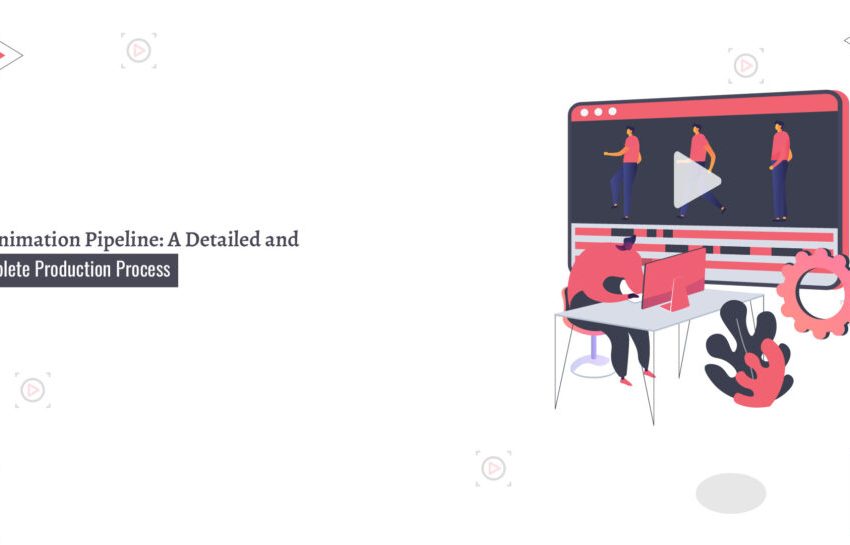What Are the Key Steps in the 2D Animation Production Pipeline?

Why Is the 2D Animation Production Pipeline Important?
Without a well-structured pipeline, the process of creating a 2D animation can become chaotic and disorganized. Projects can get delayed, budgets may be exceeded, and the final product might not meet the desired quality standards. The pipeline provides a step-by-step approach that breaks down the production into manageable tasks, allowing teams to work efficiently and communicate effectively. It also helps studios maintain consistency, avoid costly mistakes, and make necessary revisions at the right stages without wasting resources.
Stage 1: Pre-production – Laying the Groundwork
The pre-production phase is where all the planning and preparation take place. It sets the foundation for the entire project and involves defining the story, designing the characters, and creating a roadmap for production.
1. Concept Development
At the very start of the pipeline is concept development. This phase is where the initial idea for the animation is generated. During brainstorming sessions, the creative team decides on the overall theme, message, and tone of the animation. They answer questions such as, “What is the story we want to tell?” and “Who is our target audience?”
It’s important to establish a solid concept early on because it will guide every other stage of the pipeline.
2. Scriptwriting
Once the concept is finalized, the next step is scriptwriting. The script is the backbone of the entire project, outlining the dialogue, actions, and scene transitions. In 2D animation, the script doesn’t just focus on dialogue; it also details important visual elements, such as character movements and expressions, which will be brought to life through animation.
A strong script allows the creative team to understand the narrative flow, and it provides a clear guide for the animation process.
3. Storyboarding
Storyboarding is where the visual aspect of the project starts to take shape. A storyboard is essentially a sequence of sketches or illustrations that represent the flow of the animation, scene by scene. It acts as a visual script that helps the animation team map out the entire production, frame by frame.
Storyboards help identify any potential issues in pacing, transitions, or storytelling early on, allowing for adjustments before production begins. They also give the animators a clear blueprint to follow, ensuring that the animation aligns with the script and the creative vision.
4. Character and Background Design
Character design is a crucial part of the pre-production process. This is where animators create the visual appearance of the characters, defining their physical features, clothing, movements, and personalities. These designs are often accompanied by model sheets, which provide multiple views of each character to ensure consistency throughout the animation.
Similarly, background design focuses on the environments where the characters will interact. These environments can range from simple settings to elaborate worlds, depending on the scope of the project. Background artists work closely with the animators to ensure that the settings enhance the storytelling and match the overall tone and style of the animation.
Stage 2: Production – Bringing the Animation to Life
Once pre-production is complete, the project moves into the production phase. This is where the actual animation work happens, and all the planning from pre-production starts to take shape. The production phase is often the most time-intensive and laborious part of the pipeline, as it involves creating every frame of the animation.
1. Layout
The layout phase involves positioning characters, objects, and backgrounds for each scene. This stage acts as a more refined version of storyboarding, focusing on the visual composition of each shot. The layout team decides on camera angles, character placement, and scene staging, ensuring that the action flows smoothly from one frame to the next.
2. Rough Animation
Rough animation is the first pass of the actual animated sequences. At this stage, animators create the basic movements and actions of the characters. These rough drafts are not fully detailed or polished but provide a clear sense of how the characters will move and interact within each scene.
This phase is highly collaborative, as animators work closely with directors and other team members to ensure that the motion aligns with the story and the emotional beats of the characters.
3. In-betweening
Once the key actions and movements are established in the rough animation, the next step is in-betweening (or “tweening”). This process involves creating the frames that occur between the keyframes, ensuring smooth transitions and fluid motion. In-betweening can be done manually or with the help of software tools that assist in generating in-between frames.
This is where the animation begins to come to life, as it starts to move seamlessly from one action to the next.
4. Clean-up Animation
After the rough animation and in-betweening are complete, the clean-up phase begins. Clean-up animation involves refining the rough drafts, cleaning up the lines, and adding more detailed features to the characters and backgrounds. This ensures that the final animation is polished and visually consistent.
Clean-up artists ensure that every frame is neat and clear, which helps maintain the animation’s quality and overall appeal.
5. Digital Coloring
With the clean-up complete, the animation is ready for coloring. Today, most animations are colored digitally using specialized software like Toon Boom Harmony or Adobe Animate. The color artists follow a pre-established color palette to maintain consistency across all scenes. This stage also involves adding shadows, highlights, and special effects, further enhancing the animation’s visual depth.
Digital coloring allows for a wide range of creative possibilities, offering vibrant, dynamic visuals that make the animation more engaging and captivating.
Stage 3: Post-production – Polishing the Final Product
The post-production phase is where all the final elements come together to create the completed animation. This stage involves compositing, adding sound, and rendering the final output.
1. Compositing
Compositing is the process of combining all the individual elements—such as characters, backgrounds, and special effects—into a single cohesive animation. Compositing artists ensure that all the layers work together seamlessly, adjusting lighting, shadows, and any additional visual effects as needed.
This stage is crucial for making the animation look polished and professional, as it brings together all the individual components into a unified whole.
2. Sound Design and Voiceover
Sound is a critical aspect of any animation. In this phase, sound designers add background music, sound effects, and dialogue. Voiceovers, if included, are synchronized with the animated scenes to ensure that the timing matches the visuals.
Sound enhances the emotional impact of the animation, adding depth and atmosphere to the story. Well-designed sound can make scenes more immersive and help guide the audience’s emotional response to the characters and events.
3. Editing and Final Rendering
Editing involves fine-tuning the pacing, transitions, and overall flow of the animation. The editor works closely with the director to ensure that the final product meets the project’s creative goals. Once the editing is complete, the animation is ready for final rendering.
Rendering is the process of converting the animation into a final video file format. Depending on the complexity and length of the animation, rendering can take hours or even days to complete. However, once this stage is finished, the animation is ready for distribution and viewing.
Tools Used in the 2D Animation Production Pipeline
Several tools and software are used throughout the 2D animation production pipeline. Some of the most popular include:
- Toon Boom Harmony: Widely used for both traditional and cut-out animation, offering a range of features for animators.
- Adobe Animate: A versatile tool for vector-based animations, often used for web and interactive content.
- TVPaint: A powerful software for hand-drawn animations, commonly used for traditional frame-by-frame animation.
- After Effects: A go-to tool for compositing and adding special effects in post-production.
These tools streamline different stages of the pipeline, allowing animators to work more efficiently and bring their creative visions to life.
Challenges in the 2D Animation Production Pipeline
Like any creative process, the 2D animation production pipeline comes with its challenges. Tight deadlines, budget constraints, and creative differences can create hurdles during production. Additionally, changes requested by clients or directors late in the process can lead to significant rework, which can delay the project and increase costs.
To overcome these challenges, effective communication, strong project management, and flexibility are essential. Animation teams must be able to adapt to changes while maintaining a clear vision for the final product.
Conclusion
The 2D animation production pipeline is a meticulously structured process that transforms an idea into a fully realized animated production. Each stage of the pipeline—pre-production, production, and post-production—plays a vital role in bringing the animation to life. Whether it’s concept development, rough animation, or final compositing, every step is essential to achieving a polished and visually engaging final product.

